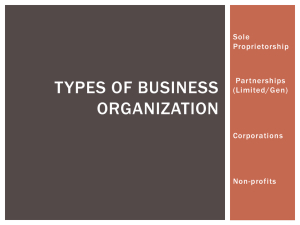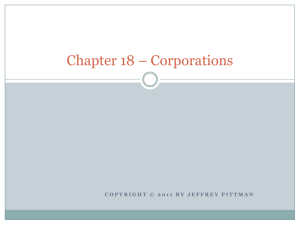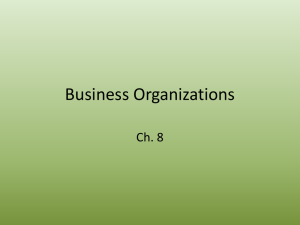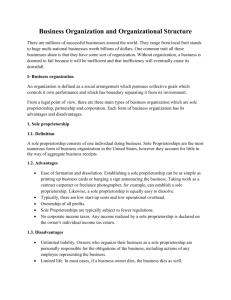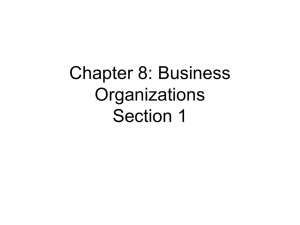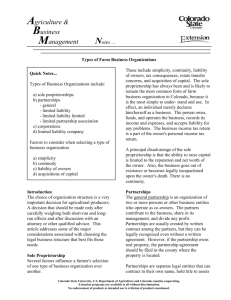Chapter 8: Business Organizations
advertisement
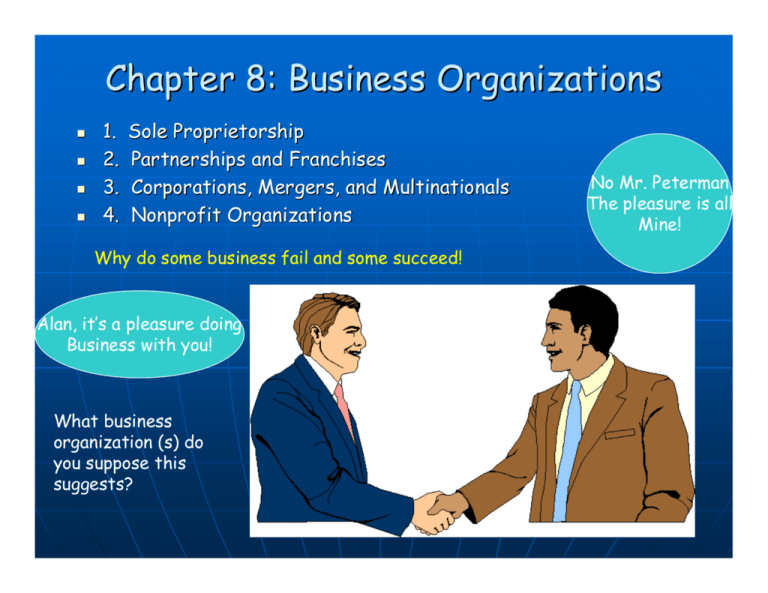
Chapter 8: Business Organizations 1. 2. 3. 4. Sole Proprietorship Partnerships and Franchises Corporations, Mergers, and Multinationals Nonprofit Organizations Why do some business fail and some succeed! Alan, it’s a pleasure doing Business with you! What business organization (s) do you suppose this suggests? No Mr. Peterman The pleasure is all Mine! Business organizations the ownership structure of a company or a firm Examples- sole proprietorship, partnership, franchise, or a corporation, non profit 1. Sole Proprietorship A business owned and managed by a single individual Sole Proprietorships ADVANTAGES DISADVANTAGES Ease of start up Fewer Regulations Sole receiver of profit Full Control Easy to discontinue Unlimited Personal Liability Limited Access to Resources Lack of Permanence Advantages of Sole Proprietorships Easy Start and End -business license- authorization from the government to operate a business Relatively few regulations -at the most zoning laws-designates certain zones as residential or business Sole Receiver of Profit – does not have to split the bill Full Control – makes all major decisions (hopefully consults wife)! Easy to discontinue – not doing well, easy to escape! Disadvantages of Sole Proprietary Unlimited Personal Liability - the legal obligations to pay debts Limited Access to Resources – you have to pay for all your materials (land, labor, capital) Lack of Permanence - lack resources to give fringe benefits, payments other than salary; no security Characteristics By Tax Return 0.7 0.6 Under $25,000 $25,000 - $49,000 0.5 0.4 0.3 $50,000 - 99,999 $100,000 - $499,000 0.2 0.1 0 What is the highest profit by tax return for a sole proprietorship? Why least? $500,000 - $999,999 $1,000,000 or more Characteristics by Type 0.2 What percentage engaged in retail over Healthcare? Real Estate 0.15 Finance and Insurance Retail M anufacturing Construction 0.1 Agriculture Accomodation and Food Service Healthcare and Social Assistance Administrative Support and Waste 0.05 M anagement, Technical Supporting Professional, Scientific, Tech Other, including legal 0 2. Partnerships and Franchises Partnerships can range in size from a pair of house painters to an accounting firm with thousands of partners. A business organization owned by two or more persons who agree on a specific division of responsibilities and profit Types of Partnerships General -all partners are equal Limited - only one partner is a general Limited Liability -all partners are limited personal liability Advantages of Partnerships Ease of Start UP – Articles of PartnershipPartnership-contract that spells out each partners rights and responsibilities Financial Impact – more than one contributing Shared Decision Making – responsibilities are shared by individuals Disadvantages of Partnerships Unlimited Liability - if one suffers they all do Potential for Conflict -cant we all just get along Lack of Permanence -may come and go Partnerships by Tax Return •What income poses in the most profit in a partnership? •How about the least? •How did this compare to proprietorship? 5% Under $25,000 8% $25,000 $49,000 $50,000 $99,000 17% 53% 9% 8% $100,000 $499,000 $500,000 $999,000 $1,00,000 or more Partnership by Type Real Estate Finance and Insurance Retail 7% 2% 2% Manufacturing 7% 48% 4% Agriculture 5% 6% 2% Consruction Accommodation and food services 6% 11% Healthcare Management Professional Using the data, describe partnerships in terms of industry and income. Why do you think real estate businesses form the largest percentage of partnerships? Other, legal Business Franchises Is a independent business that pays fees to a parent company Examples from fast food restaurants to jewelry stores Advantages of Franchises Managing Training and Support – franchises offer training and support programs Standardized Quality – certain rules and processes to guarantee product quality National Advertising Programs – parent companies pay and you don’t have to pay Financial Assistance – Some franchisers provide financing to help owners start their business Centralized Buying Power – buying materials in bulk for all their locations Disadvantages of Franchises High Fees and Royalties –Franchises charge high fees to use their name, they also expect royalties Strict Operational Standards –strict rules such as hours of operation, dress codes, and operating procedures Purchasing Restrictions – franchises can only buy from the parent company Limited Product Line – offer only approved products Global Business, Local Taste Foreign UPS 2007 Foreign Subway Foreign McDs 2005 Domestic UPS Domestic Subway 2003 Domestic McDs 0 10,000 20,000 30,000 3. Corporations, Mergers, and Multinationals A legal entity, or being, owned by individual stockholders, each of whom has limited liability for the firm’s debts A stock -a certificate of ownership in a corporation By Tax Return 18% 24% Under $25,000 $25,000 - $49,000 11% $50,000 - $99,000 6% $100,000 - $499,000 $500,000 - $999,000 10% $1,000,00 or more 31% •What percent is under $25,000? •What income represents the least among of corporations owned by individual stock holders? How about the most? Types of Corporations Closely held corporations -issues stocks to only a few people, who are often family members Publically held corporations -sells stock on the open market Five groups of people: stockholders, board of directors, corporate offices, managers, and employees Corporate officers INVEST IN MY CORPORATION Stockholders directors Corporate officers Board of Employees Mangers By Type 12% 12% Real Estate 5% Finance and Insurance Retail M anufacturing 15% Construction Agriculture 12% 4% Accomodation and Food Services Healthcare and Social Assistance 6% M anagement Professional 7% Other services, including legal 6% 14% 3% Approximately 38% of corporations are engaged in construction, manufacturing, real estate, and retail business. What incentives to incorporate do businesses have in these industries? Firms that sell services make up a large fraction of corporations. Given this fact, what can you conclude about the U.S. Economy? Advantages of Incorporation Incorporation, or forming a corporation, offers advantages to both stockholders and the corporation itself. Limited liability for owners - advantage for Stockholders because you don’t carry personal responsibility for the corporation’s actions! You will lose or gain only the amount of money you have invested in the business. Advantage for a corporation – by selling shares they can raise large amounts of capital Ability to attract capital by use of bonds -promise to repay borrowed money with interest at fixed variables Transferable ownership – shares of stocks are easily transferable; not the case with other business organizations Long life or permanence -because stocks are transferable, corporations can last longer that partnerships and sole proprietorships Disadvantages of Incorporation Expense and difficulty of start up -certificate of incorporation-a license issued by the state government YOU MUST FILE!!! Double taxation -corporations legal entities separate from their owners MEANS MUST PAY TAXES ON IT!!! Dividends -portion of corporate profits paid out to stockholders Stockholders have to claim dividends as personal income Limited Liability Corporations – advantage of limited liability for owners and tax advantage; do not pay corporate income tax Potential loss of control by the founders –corporate officers and boards of directors, not owners, manage corporations and sometimes they make very bad decisions. Corporation Combinations Horizontal merger – join two or more firms competing in the same market with the same good Vertical merger – join two or more firms involved in different stages of producing the same good or service Conglomerates -merging more than three businesses that produce unrelated products and services • Examples include Coca Cola, Time Warner, Walt Disney Horizontal Merger Combined Oil Company Independent Oil Refiners Vertical Merger Combined Steel Company Steel Mills Ore deposits Railroads Ships Coke fields Multinational Corporations Large corporation that produces and sells in more than one country These are the world’s largest! Headquarters in one country and branches in the other. They must obey laws and pay taxes in each country where they operate. •Early 2000’s, an estimated 64,000 multinational firms operated 866,000 foreign branches. •These affiliates provide jobs to 53 million people! •The United States, Great Britain, Germany, Japan, France, China are the one’s with the largest amounts! Advantages of Multinational Provides products and job around the world -benefits consumers and workers Helps poorer nation – enjoy better living standards Spreads new technology and production methods – across the globe Disadvantages of Multinational Poor jobs- unduly influence the culture and politics low wages – high demand for workers poor working conditions - not treated fairly (just like laborers in the U.S. in the late 1800s) 4. Nonprofit Organizations An institution that functions much like a business, but does not operate for the purpose of generating profit Professional organizations -works to improve image, working conditions, and skill levels Business association - promote the collective business interests of an area Trade association – promotes interests of particular industry Labor union – aim is to improve working conditions Examples include museums, public schools, the American Red Cross, hospitals, adoption agencies, churches, synagogues, YMCA’s (MOST provide service, not a good)! America’s first Cooperative Ben Franklin, one of our nation’s founders, was a remarkable innovator. In 1752, he formed a company that collected money from its members in order to make payments to any one of them who suffered losses from a fire. He wrote, “I would leave this to the Consideration of all who are concern’d for their own or their Neighbour’s Temporal Happiness; and I am humbly of Opinion, that the Country is ripe for many such Friendly Societies, whereby every Man might help another, without any Disservice to himself.” The New-England Courant, August 13, 1722 Cooperatives A business organization owned and operated by a group of individuals for their shared benefit Consumer Cooperative – retail owned and sell items at a low price Service Cooperative – provides a service not a good Producer Cooperative – agricultural marketing which helps sell product (farming and energy to healthcare and childcare) Voluntary and open membership Control of the organization by its members Sharing of contributions and benefits by members Business Organizations ADVANTAGES DISADVANTAGES Sole Proprietorships Ease of start up Fewer Regulations Sole receiver of profit Full Control Easy to discontinue Unlimited Personal Liability Limited Access to Resources Lack of Permanence Partnerships Ease of start up Shared decision making More capital Attractive to employees Unlimited liability Lack of Control Potential for conflict Lack of Permanence Business Franchise BuiltBuilt-in Reputation Management Training Paid national advertising Financial Assistance Centralized buying power High fees/royalties Strict operating standards Purchasing restrictions Limited Product line Corporation Potential for Growth Ability to raise capital Long lifespan Ability to hire specialists Difficult start up Double taxation Loss of control More regulation
